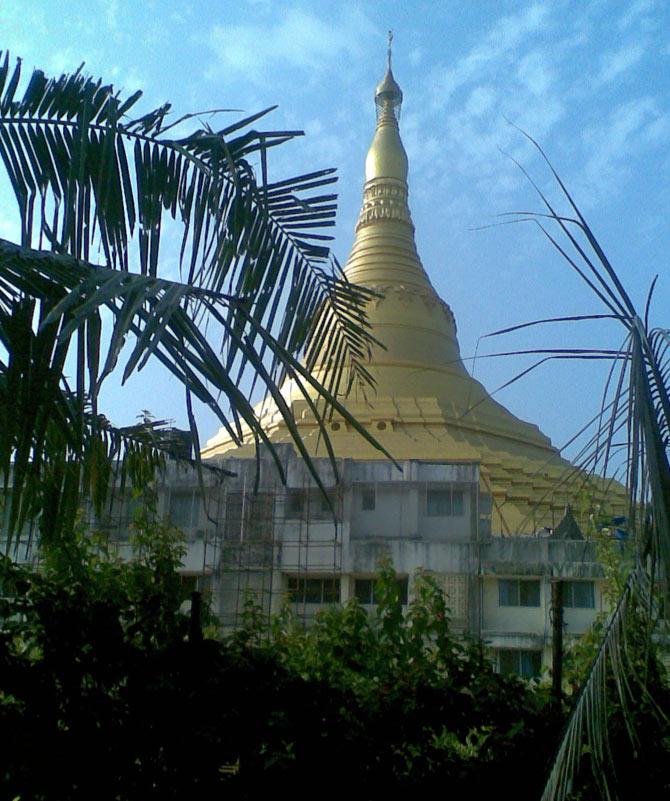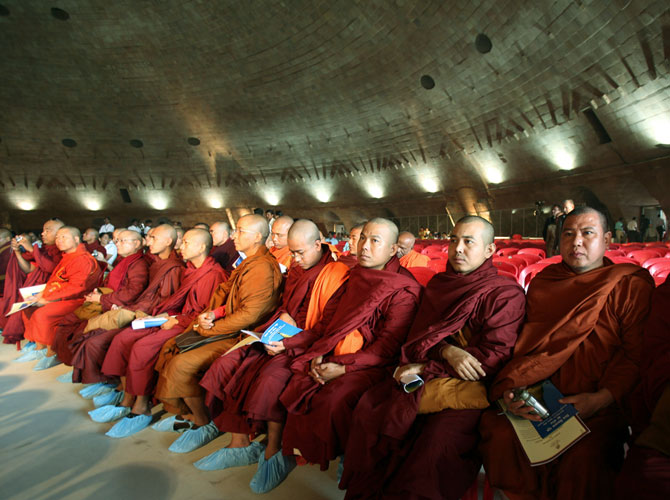Photographs: Rajesh Karkera/Rediff.com Saisuresh Sivaswamy
Like thousands of Indians and non-Indians, I have been touched by, and am a beneficiary, of Satya Narayan Goenka's single biggest contribution to humanity: the Vipassana brand of meditation.
I don’t claim to know Satya Narayan Goenka at all, nor have I ever met him.
But like thousands of people, Indian and non-Indian, I have been touched by, and am a beneficiary, of his single biggest contribution to humanity: the Vipassana brand of meditation, which harks back to the Buddhist technique, as taught and espoused by Gautama the Buddha two millennia ago.
So what is this Vipassana? What is unique about it in a land steeped in ancient spiritualism, where street corners abound with purveyors of moksha and nirvana? Every ashram worth its Om in the country teaches you meditation techniques, as do legions of yoga teachers and new age experts who promise to awaken your Kundalini and Qi through chanting, breathing exercises and more exotic things.
So how does Vipassana fit into this larger scheme of things? And, what explains the popularity of a Buddhist technique in a land that is predominantly Hindu and which shares a rather uncomfortable level of coexistence with the religion that emerged as a corrective to the existing system before being institutionalised as a religion itself and ended up replacing the mother faith in its land of origin before being driven out?
And, in that sense, was Mr Goenka an evangelist, a proselytizer or sorts who is hiding the larger scheme behind an innocent facade?
I must admit that when you first hear of Vipassana from friends and others who have undergone the experience, it can sound daunting.
Ten days in seclusion?
Ten days of no conversation at all?
Ten days simple, vegetarian food?
Ten days of simple, monastic life?
Ten days of being offline?
Ten days of waking up in the Brahma Muhurta (the early hours before sunrise) and sleeping by 9 pm?
And, ironically from Indians this, the most difficult thing to do: What, 10 days of sitting cross-legged? Are you crazy, man?!
...
Mr Goenka is dead, long live Vipassana!
Image: Buddhist monks at the Golden Vipassana Pagoda at Gorai, outside MumbaiPhotographs: Punit Paranjpe/Reuters
The thing that strikes you about Vipassana when you steel yourself, enroll for it (sometimes it could take months to get a booking), reach the venue (at any of the numerous centres dotting India and the world), is that it is all unlike any other meditation course, ashram stint, you have done before.
For one, Vipassana, thanks to its rebellious breakaway from traditional Hindu priestly practices (read rituals), has no overtones of religion. No aarti, no puja, no sacred mantra being whispered to you to hold in confidence and to recite. So much so, it is highly liberating.
For another, it is completely non-denominational.
The thing I find about our ashrams is that while they welcome members of all faiths without discrimination, in the grandest tradition of this land’s Vasudev Kutumbakam heritage, the practice most often is outright Hindu. Nothing wrong in that, of course. After all, when you join a Christian seminary or go to a dargah the practices there are rooted in the respective faiths.
Some ashrams try to address the slight discomfort felt by non-Hindu participants by suggesting Amen and Ameen in place of Om, but nevertheless overall the effect remains rooted in one faith only. Some practitioners are able to see the larger picture, realise that there is but one Universal Truth, and throw themselves into the proceedings with gusto but for many starting out on the path and dipping their toes into the vast sea of spirituality, the overt religious connotations can come as a bummer.
Like Gautama before him, Goenka realised that the message was often getting lost in the rituals, and simply cut the crap. So here is the simple path to discovering yourself, just by watching your breath, experiencing its feel on your body. What you are told to do in the 10 days you spend in the Vipassana camp is to leave your baggage of faith behind, to travel lightly. In fact, not carry any baggage at all, so you don’t clutter your rack with unwanted things.
...
Mr Goenka is dead, long live Vipassana!
Image: Policemen participate in a Vipassana meditation programme in DelhiPhotographs: Reuters
In between meditating on the breath there are tapes of Mr Goenka’s scratchy voice guiding you on the path to meditation, and apart from two meals a day, seclusion and silence, you realise you are left to deal with the demons in your mind by yourself. We seek noise, you then realise, because we are afraid to hear our own silence, to be left alone with ourselves. The horrible truth is that we can’t handle ourselves, and hence seek company, conversation, anything to shut up that fellow inside.
The path to salvation, every teacher will tell you, lies in knowing yourself first. Each school has a different way of achieving this. Ramana, the mendicant patron saint of Thiruvannamalai, says to start with the question, Who am I, and to meditate on it. Goenka’s path may not be entirely dissimilar, and hence the answer is the same.
And when you see people turning emotional, unable to bear the answers the silence churns out of their internal ocean, you realise the power of the ancient technique Mr Goenka rescued out of obscurity, you realise the potency of Gautama’s way.
And when you see people heading for a second, third and further sips of Vipassana, and emerge better for the experience, you realise the greatness of Goenka’s legacy that can never be lost again. He may have passed into the ages, but what Goenka has gifted humanity will stay with us forever.




article